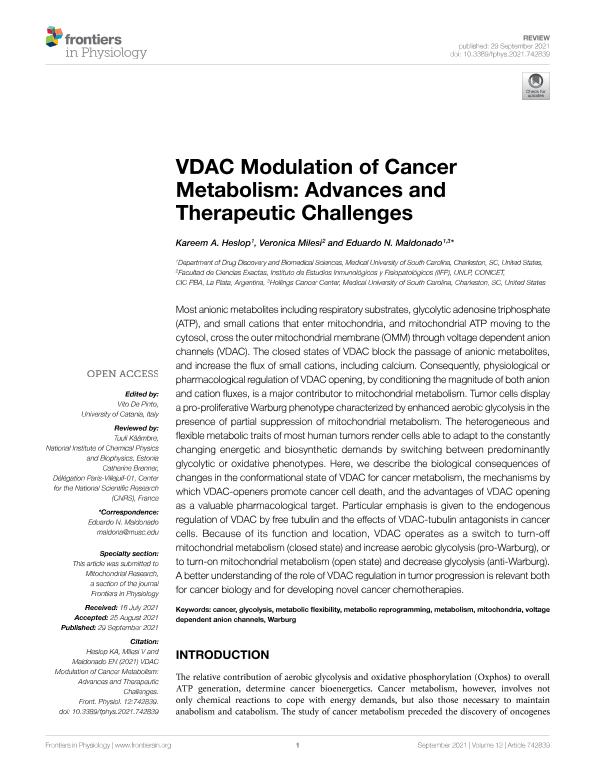Mostrar el registro sencillo del ítem
dc.contributor.author
Heslop, Kareem A.
dc.contributor.author
Milesi, Verónica

dc.contributor.author
Maldonado, Eduardo N.
dc.date.available
2022-12-14T11:21:36Z
dc.date.issued
2021-09
dc.identifier.citation
Heslop, Kareem A.; Milesi, Verónica; Maldonado, Eduardo N.; VDAC Modulation of Cancer Metabolism: Advances and Therapeutic Challenges; Frontiers Media; Frontiers in Physiology; 12; 9-2021; 1-12
dc.identifier.issn
1664-042X
dc.identifier.uri
http://hdl.handle.net/11336/181061
dc.description.abstract
Most anionic metabolites including respiratory substrates, glycolytic adenosine triphosphate (ATP), and small cations that enter mitochondria, and mitochondrial ATP moving to the cytosol, cross the outer mitochondrial membrane (OMM) through voltage dependent anion channels (VDAC). The closed states of VDAC block the passage of anionic metabolites, and increase the flux of small cations, including calcium. Consequently, physiological or pharmacological regulation of VDAC opening, by conditioning the magnitude of both anion and cation fluxes, is a major contributor to mitochondrial metabolism. Tumor cells display a pro-proliferative Warburg phenotype characterized by enhanced aerobic glycolysis in the presence of partial suppression of mitochondrial metabolism. The heterogeneous and flexible metabolic traits of most human tumors render cells able to adapt to the constantly changing energetic and biosynthetic demands by switching between predominantly glycolytic or oxidative phenotypes. Here, we describe the biological consequences of changes in the conformational state of VDAC for cancer metabolism, the mechanisms by which VDAC-openers promote cancer cell death, and the advantages of VDAC opening as a valuable pharmacological target. Particular emphasis is given to the endogenous regulation of VDAC by free tubulin and the effects of VDAC-tubulin antagonists in cancer cells. Because of its function and location, VDAC operates as a switch to turn-off mitochondrial metabolism (closed state) and increase aerobic glycolysis (pro-Warburg), or to turn-on mitochondrial metabolism (open state) and decrease glycolysis (anti-Warburg). A better understanding of the role of VDAC regulation in tumor progression is relevant both for cancer biology and for developing novel cancer chemotherapies.
dc.format
application/pdf
dc.language.iso
eng
dc.publisher
Frontiers Media

dc.rights
info:eu-repo/semantics/openAccess
dc.rights.uri
https://creativecommons.org/licenses/by-nc-sa/2.5/ar/
dc.subject
CANCER
dc.subject
GLYCOLYSIS
dc.subject
METABOLIC FLEXIBILITY
dc.subject
METABOLIC REPROGRAMMING
dc.subject
METABOLISM
dc.subject
MITOCHONDRIA
dc.subject
VOLTAGE DEPENDENT ANION CHANNELS
dc.subject
WARBURG
dc.subject.classification
Biofísica

dc.subject.classification
Ciencias Biológicas

dc.subject.classification
CIENCIAS NATURALES Y EXACTAS

dc.title
VDAC Modulation of Cancer Metabolism: Advances and Therapeutic Challenges
dc.type
info:eu-repo/semantics/article
dc.type
info:ar-repo/semantics/artículo
dc.type
info:eu-repo/semantics/publishedVersion
dc.date.updated
2022-09-22T12:45:21Z
dc.journal.volume
12
dc.journal.pagination
1-12
dc.journal.pais
Suiza

dc.description.fil
Fil: Heslop, Kareem A.. University of North Carolina; Estados Unidos
dc.description.fil
Fil: Milesi, Verónica. Consejo Nacional de Investigaciones Científicas y Técnicas. Centro Científico Tecnológico Conicet - La Plata. Instituto de Estudios Inmunológicos y Fisiopatológicos. Universidad Nacional de La Plata. Facultad de Ciencias Exactas. Instituto de Estudios Inmunológicos y Fisiopatológicos; Argentina
dc.description.fil
Fil: Maldonado, Eduardo N.. University of North Carolina; Estados Unidos
dc.journal.title
Frontiers in Physiology
dc.relation.alternativeid
info:eu-repo/semantics/altIdentifier/url/https://www.frontiersin.org/articles/10.3389/fphys.2021.742839/full
dc.relation.alternativeid
info:eu-repo/semantics/altIdentifier/doi/http://dx.doi.org/10.3389/fphys.2021.742839
Archivos asociados
